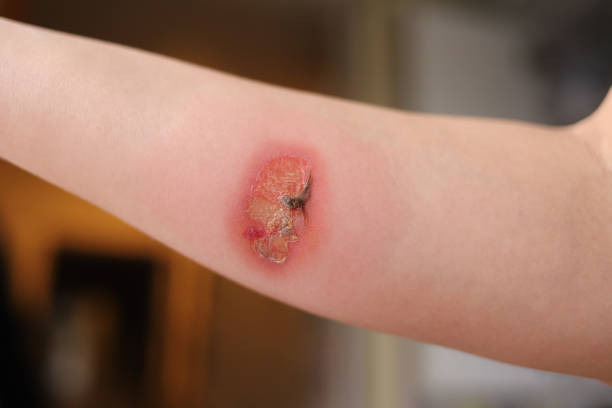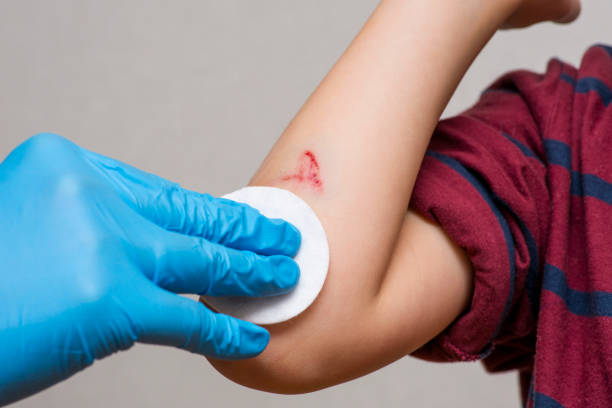Infection vs Inflammation: What Your Wound Is Telling You
Redness, Swelling, and Drainage — What's Normal and What's Not?


Many people confuse wound inflammation with infection because of how similar their symptoms can be. This mistake often leads to slower healing and unnecessary antibiotic use. Think of your wound like a construction site: inflammation is the cleanup crew that arrives first to clear the debris and get things ready for repair. Infection, on the other hand, is like vandals that sneak onto the site, spreading damage and putting the whole project at risk. The tricky part is that from the outside, both can look similar. Learn to read and compare the signs of wound infection vs. inflammation to differentiate the two and determine when it's time to get medical attention.
IN THIS ARTICLE
- What Is Inflammation?
- What Is a Wound Infection?
- Wound Inflammation vs. Infection: How to Tell the Difference
- Key Differences Between Inflammation and Infection
- When to Seek Medical Attention
- How Dermatologists Treat Infected Wounds
- Preventing Infection During the Healing Process
- Wound Care in Northern Colorado
- Infection vs. Inflammation FAQs
When you get injured, your body springs into action to protect you. As a result, you may notice inflammation symptoms, such as swelling, redness, or tenderness, appearing a few days after injury.
Inflammation is a normal body mechanism involving various immune cells. For others, the term has a negative implication, but in reality, it's a natural physiological response, indicating your immune system is doing its job well.
When you get a cut, the immune cells release inflammatory mediators. These mediators, such as bradykinin and histamine, dilate small blood vessels near the wound, allowing more oxygen-rich blood to reach the area to set the stage for tissue repair. Inflammation is a positive sign that your immune system is capable of orchestrating the skin repair process in case of damage.
Sometimes, inflammation can progress into an infection and become an even bigger problem. This happens when disease-causing microorganisms like bacteria or germs find their way into your wound, disrupting the healing process and triggering various reactions in the body.
Common signs of wound infection include increasing pain, spreading redness, foul odor, and pus in the affected area. Severe cases are often accompanied by fever, chills, and fatigue, signaling your immune system is working extra hard.
Signs of infection typically appear several days after an injury or even later if a previously calm wound suddenly acts up. To prevent the worst-case scenario, proper wound care treatment is crucial, even for a minor injury.
This table helps you tell apart inflammation from infection based on the severity of symptoms.
Consult a dermatologist if you notice any of the following signs of wound infection:
- Pain, swelling, or drainage that's worsening: When swelling intensifies and the wound shows no signs of healing, visit your skin doctor.
- Red streaks extending from the wound: It's a sign the infection has spread through your lymphatic vessels and requires more than just at-home treatment.
- Fever or chills: A higher body temperature means your immune system is overworking to help the white blood cells get rid of the root cause of the infection.
- Your wound isn’t improving after a week: The healing process goes through several phases. By days 5 through 7, you should see signs of normal wound healing, such as new tissue forming on the wound to keep it stable. If your wound doesn't get better after this time, consult your healthcare provider.
Never underestimate a minor wound infection because it can potentially develop into severe complications, like sepsis or gangrene, which can be fatal.

Here's the step-by-step process on how a skin specialist treats infected wounds:
- Initial evaluation: They examine the wound and how severe it is, ensuring delayed healing isn't due to underlying issues such as diabetes or poor circulation.
- Debridement (if needed): They carefully remove dead or damaged tissue from a wound to help it heal faster.
- Silver-infused dressings: These products boast powerful antimicrobial properties and help inhibit the growth of bacteria when applied to the wound site.
- Topical or oral antibiotics: For more serious cases, your doctor may prescribe topical creams to address localized infections or oral antibiotics to treat infections from within.
- VaporOx or advanced therapies for chronic infections: These breakthrough treatment methods use technology like the VHT system to promote healing.

The body progresses through four wound healing stages: inflammatory, proliferative, maturation, and remodeling. Here are some tips on how to protect a healing wound and speed up recovery.
1. Practice good wound hygiene and clean the wound as directed by your dermatologist.
2. Use proper dressings to prevent bacteria from entering the wound.
3. Don’t pick or scratch the wound as it might reopen it.
4. Keep the area dry and clean unless your doctor tells you otherwise.
5. Monitor symptoms daily and contact your doctor immediately if redness or swelling worsens.
6. Follow post-surgical care instructions to speed up your healing.
Knowing when to see a doctor is crucial for timely wound treatment. At-home remedies often work well for minor wounds with mild swelling and redness, but if red streaks, pus, or foul odor appear, a serious infection could be brewing.
When this happens, visit us at Altitude Dermatology so our board-certified dermatologist can examine the wound and devise a treatment plan suited for you. Meet our providers in Johnstown, Longmont, and soon in Fort Collins. They specialize in treating a wide range of conditions, from common skin issues to chronic wound infections, using advanced treatments like VaporOx and skin substitutes.
Don’t wait for your wound to get worse. If you’re unsure whether it’s infected or just healing, let our dermatology experts take a look.
